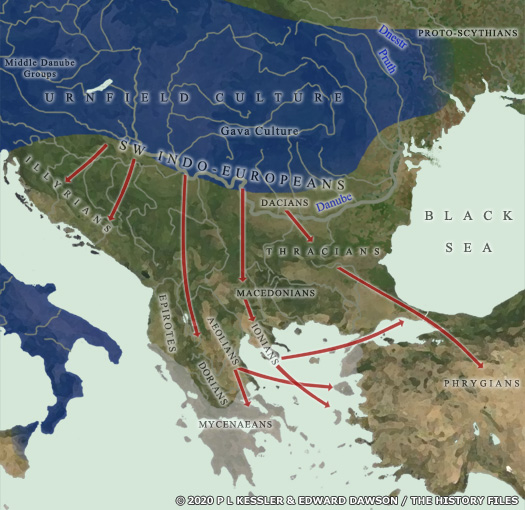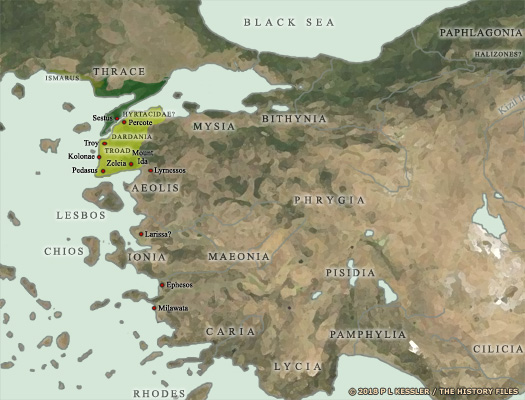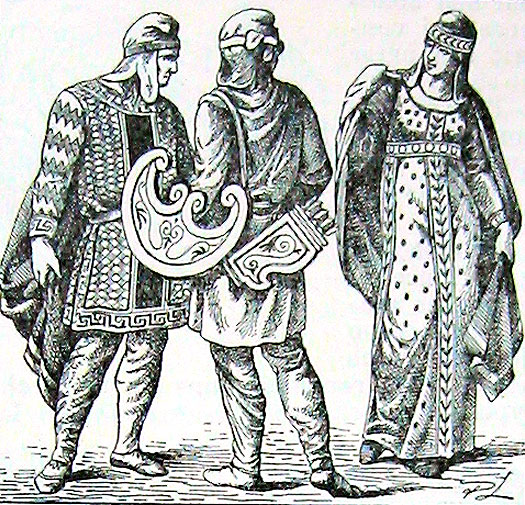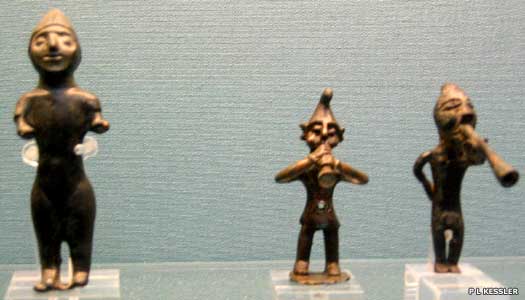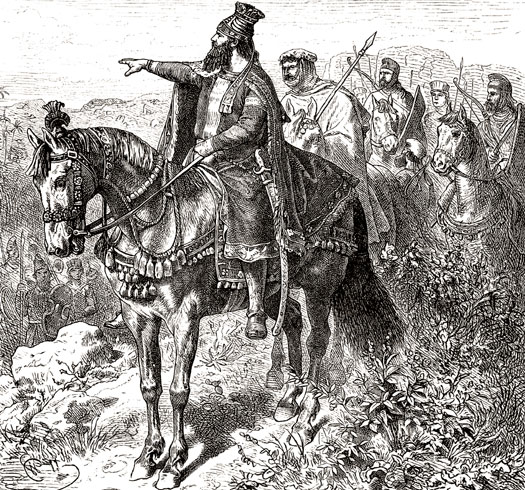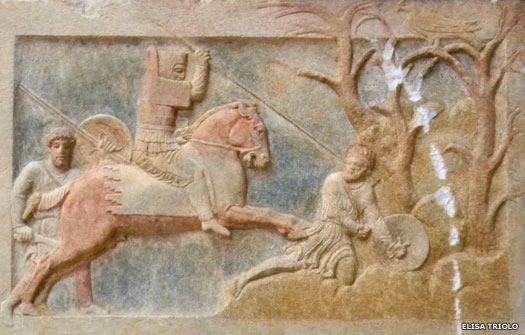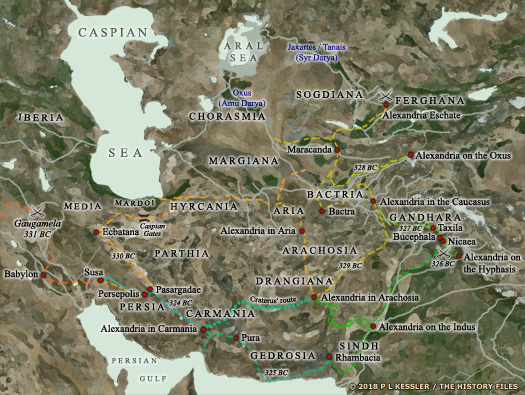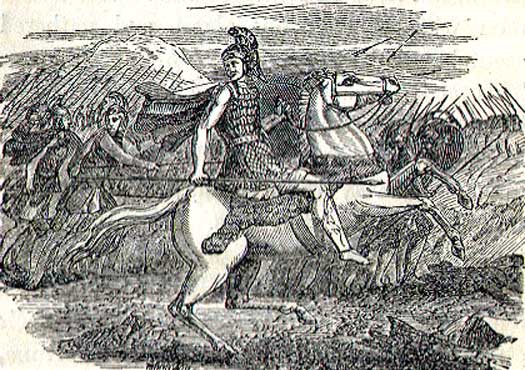
| PHRYGIANS Incorporating the Bryges, Muku, Mygdonians, & Phryges :
Area of Anatolia have been occupied almost since the initial lasting steps out of Africa by modern humans. It was the birthplace of the great farming revolution which signalled a massive change in human nutrition, living standards, and advances towards civilisation. That revolution soon spread into Europe via the Sesklo culture of 'Old Europe' but, several millennia later, came the bounce-back in the form of the Yamnaya horizon and the migration of Indo-European peoples from the Pontic steppe. Initially they were limited to the banks of the Danube but then they quickly expanded across what is now Romania and the northern Balkans region. A climate-induced drought around 1200 BC saw these Balkans tribes forced into a further migration southwards across the rest of the Balkans while one group - the Phrygians - had seemingly already started to use a route which took them across the Bosphorus and into Bithynia in western Anatolia.
That Balkans origin for the Phrygians has been debated, and not all modern scholars accept it. Herodotus noted it, amongst others which include Strabo, referring to the tribe there as being known as the Bryges (Brygi or Briges) until it had crossed into Anatolia. After that the name became Phryges - the same Greek word (and not the Phrygian native name) but with a change in pronunciation which hints at a level of influence from a new interaction, perhaps with already-settled Indo-Europeans in the region such as the Luwians. Appian at least did not regard the Bryges as Illyrians, unlike the people who dominated that region for much of the first millennium BC. Despite attempting to remain in the Balkans when part of their number had already left, the Bryges were soon displaced by the incoming Taulantii. Not heard of again, perhaps they followed the migration route to join the rest of their compatriots in Anatolia.
The main migration supposedly took place immediately after the Trojan War - placing it directly into the time of the major migration shift from the Balkans into Greece. However, the Phrygian migration is likely to have started earlier, perhaps after about 1450 BC, and consisted of gradual advances by small groups of people rather then being one mass movement that crashed its way into Anatolia. Greek writer Conon places its start ninety years before the Trojan War while the earliest written source, Homer, has the Phrygians already in place, and allied to Troy. There was clearly an established tradition in place concerning an early Phrygian arrival, of at least a couple of generations prior to the war.
Largely moving towards western central Anatolia, the early Phrygians settled a region that is a little way inland from the north-western corner of Anatolia, bordering Mysia and the Troad to their west. Linguistically, they bore some relationship to the Armenians who later occupied the mountains on the northern edge of Mesopotamia, and also with the Thracians, who remained on the European side of the Bosphorus. The Assyrians possibly knew these Phrygians as the Mušku or Mushki, a name that first appeared in Assyrian records in the twelfth and eleventh centuries BC when it was the Mušku who were penetrating into the Upper Tigris. The link between Phrygians and Mušku has been as hotly debated in recent years as the claim of Phrygians originating in the Balkans. Kopanias in his 2015 work points out the Arzawan country of Maša or Masha which is mentioned in Hittite texts, which could well have become Phrygian territory if the Mašans (probably Mysians) were forced westwards by their arrival, with the result that the Mušku were Phrygians of the Masha country specifically (taking into account changes in pronunciation between Hittite rule and that of the Phrygians).
If they had indeed arrived early enough, the Phrygians could have been involved along with the nearby Kaskans in the final fall of the Hittite empire. With that gone the region suffered a power vacuum which the Phrygians seem to have been best placed to fill when it came to inland territories. Thereafter, they found themselves bordered to the south-west by the neo-Hittite kingdom of Maeonia, with Mysia and the rest of the Troad forming part of their extended territory. The Mysians especially seem to have enjoyed close relations with the Phrygians, while the Mygdonians were often equated directly with the Phrygians and only disappeared later in history, probably having been absorbed by the Phrygians. A recognisably unified kingdom emerged by the eighth century BC, while no less than two lines of kings from Greek legend predates that.
(Information by Peter Kessler and Edward Dawson, with additional information from The Histories, Herodotus (Penguin, 1996), from Europe Before History, Kristian Kristiansen, from A Dictionary of Greek and Roman Biography and Mythology, William Smith (Ed), from An Historical Geography of Europe, Norman J G Pounds (Abridged Version), from The Horse, the Wheel, and Language: How Bronze-Age Riders from the Eurasian Steppes Shaped the Modern World, David W Anthony, from History of Humanity - Scientific and Cultural Development: From the Third Millennium to the Seventh Century BC (Vol II), Ahmad Hasan Dani, Jean-Pierre Mohen, J L Lorenzo, & V M Masson (Unesco 1996), from The Iliad, Homer (Translated by E V Rieu, Penguin Books, 1963), and from External Links: Metropolitan Museum of Art, and Geography, Strabo (H C Hamilton & W Falconer, London, 1903, Perseus Online Edition), and Massive migration from the steppe was a source for Indo-European languages in Europe (Nature), and Indo-European Etymological Dictionary, J Pokorny, and The Mushki/Phrygian problem from the Near Eastern point of view (NOSTOI. Indigenous Culture, Migration and Integration in the Aegean Islands and Western Anatolia during the Late Bronze and Early Iron Age (Proceedings of the International Conference Istanbul 2011, ? Stampolides, C Maner, & K Kopanias (Eds, Istanbul: Koç University Press, 2015).)
c.1450 BC :
If this approximate date for the arrival of Phrygians in Anatolia is remotely accurate then that arrival predates the climate-induced drought and crop collapse at the end of the thirteenth century BC. Food supplies dwindle and the number of raids by various patchwork groups who have banded together greatly increases until, by about 1200 BC, this flood has turned into a tidal wave of destruction, abandonment, and migration.
Climate-induced drought in the thirteenth century BC created great instability in the entire eastern Mediterranean region, resulting in mass migration in the Balkans, as well as the fall of city states and kingdoms further east The same climate-induced hardships also hit the descendants of Indo-European settlers along the Danube and in Romania, descendants who have already expanded into the northern Balkans. They begin to migrate southwards in search of food and better circumstances, perhaps also helped on by the growing dominance of the Urnfield culture (in the local form of the Gava culture) to their north.
The proto-Thracians take the south-eastern corner of the Balkans. The proto-Phrygians take a similar route but carry on going until they have crossed into Anatolia - possibly following an already-established route. Greek writer Conan has Phrygians arriving in Anatolia around the 1270s BC, while Homer suggests that they are settled and part of the establishment by the time of the Trojan Wars, and therefore must have arrived at least a couple of generations beforehand - a date which must be close to the 1270s BC. A tradition of an early arrival clearly exists.
c.1220 BC :
Phineas of Thrace is rescued from an island which is apparently part of Phrygia. He is being plagued there by harpies, but is saved by Jason of Iolkos during the latter's quest for the Golden Fleece. This episode serves to introduce Trojan-era Phrygia to history, although how historical such a kingdom may be is highly questionable.
Dymas : His dau, Hecuba, m Priam of Troy.
fl c.1200 BC :
In Greek mythology, Dymas marries his daughter, Hecuba, to Priam, king of Troy, while (according to Homer) his son, Asius, fights and dies in the Trojan War. Dymas and his Phrygian subjects are closely connected to the River Sangarius, which empties into the Black Sea. This not only indicates their location in western central Anatolia - it remains a central part of the later historical kingdom.
fl c.1180s BC :
Asius : Son.
fl c.1180s BC :
Ascanius : A Phrygian leader. Killed at Troy.
c.1193 - 1183 BC :
Prince Asius leads the Phrygian contingent from remote Ascania to the Trojan War on the side of Troy. He is accompanied by fellow commanders Ascanius and Phorcys. The latter is killed by Ajax, while Ascanius, son of Aretaon, may be the brother of Phorcys (Greek myth is unclear and contradictory here). This Aretaon may be the same one who is killed at Troy by Teucer of Cyprus. Asius survives the war.
Troy's various regional allies at the time of the Trojan War are shown here, many of which are only mentioned in later works by Homer, Herodotus, and other Greek chroniclers Tantalus begins what would seem to be a parallel line of kings in Phrygia, although Greek myths are hopelessly muddled and contradictory in these matters. He supposedly rules a generation or two before the fall of Troy, and his descendant Mygdon rules immediately before. This Tantalus seems not to be the same as the Tantalus of Maeonia, while Mygdon governs a group known as the Mygdonians who are often linked closely to the Phrygians. A solution would be to divide Phrygia into two or more tribal regions at this time, each with its own kingship and presence in The Iliad.
fl c.1250 BC :
Tantalus : Father of Daskylos, a king of Mysia.
Tantalus is possibly the father of Daskylos, a king of Mysia in Greek mythology or a tribal leader of the Mariandyni. The estimated dating for both kingdoms would seem to match up well enough for this indeed to be the case. Daskylos attempts to marry one of his sons to the king of Troy, although the boy is killed on his way to the city. The Mysians would appear either to be recent arrivals in the region or have recently founded their own kingdom following the Hittite collapse, just like the Phrygians, and are no doubt attempting to cement their position.
Teuphrant
Teleph
Tarhont Acmon : Eponymous founder of the region of Acmonia.
Mygdon / Migdon : Son. Father of Coroebus.
fl c.1190 BC : The name of the Mygdonians is often used synonymously with that of the Phrygians, and Homer refers to the leader of the Phrygians as Mygdon. According to Stephanus Byzantius, Mygdonia had been the name of a district in the later Great Phrygia and also in Macedonia. At a later time the Mygdonians disappear from history, probably being absorbed by the Phrygians.
This relatively recent view shows Phrygian costume at the height of the later kingdom's power, as attested by surviving visual records, especially of the peaked cap ? - 1183 BC :
Curtius : The last Trojan-era king? Killed at Troy. The line of kings seems to end with Curtius and his death at Troy while defending Cassandra, or at least is not recorded past this point. The reason could be one of quite a few options, starting with the fact that the entire Near East is entering a dark age at this point, with written records from Anatolia already having dried up. The Phrygians may indeed arrive after the Trojan War to claim the area and perhaps put paid to the last of these Trojan-era kings, or this early - perhaps Phrygian - nobility is subsumed by later, stronger arrivals and a rebuilt kingdom of Phrygia takes time to emerge into history.
Phrygia :
The early Phrygians settled a region that is a little way inland from the north-western corner of Anatolia, bordering Mysia and the Troad to their west. The Assyrians possibly knew these Phrygians as the Muku, a name that first appeared in Assyrian records in the twelfth and eleventh centuries BC when it was the Muku who were penetrating into the Upper Tigris. The link is contentious, but Sargon II actually names the Muku king as Mita, a name which is very close to the Midas of Greek texts and a king who was involved in several attacks against Assyrian targets.
The earliest Phrygian king known to history is Gordios I. Given the dates for his descendant, King Midas III, his own rule may have taken place around the 820s BC, give or take a decade or so. Both Gordios and Midas, or Mita, are Luwian names, showing that the Phrygians either picked up on some Luwian cultural and linguistic traits - and possibly intermarried with whatever surviving Luwian nobility remained after the fall of Hattusa - or that the Luwian elements took control of the arriving Phrygians and remained dominant.
(Information by Peter Kessler with additional information from The Histories, Herodotus (Penguin, 1996), from A Dictionary of Greek and Roman Biography and Mythology, William Smith (Ed), from An Historical Geography of Europe, Norman J G Pounds (Abridged Version), and from External Links: Metropolitan Museum of Art, and Geography, Strabo (H C Hamilton & W Falconer, London, 1903, Perseus Online Edition), and The Mushki/Phrygian problem from the Near Eastern point of view (NOSTOI. Indigenous Culture, Migration and Integration in the Aegean Islands and Western Anatolia during the Late Bronze and Early Iron Age (Proceedings of the International Conference Istanbul 2011, Ν Stampolides, C Maner, & K Kopanias (Eds, Istanbul: Koç University Press, 2015).)
fl c.820s? BC :
Gordios I : First historical Phrygian king. Luwian name.
Midas I : Another Luwian name.
Gordios II
Midas II
Gordios III
c.740 BC :
The Great Tumulus of Gordion is long thought to be the burial mound of Midas (he of the fantastic fortune in gold). It is even called MM (Midas Mound) by the excavators who uncover it. But the dendrochronological analysis of the wooden beams used to cover the burial chamber later shows that it is constructed around 740 BC, very close to the presumed date of death of Gordios III. The tumulus contains rich finds which demonstrate the existence of contacts with Assyria, although these are not attested in written sources. In particular, the bronze vessels used for drinking wine at the deceased's funeral and subsequently buried with him attest to the shared elite culture: like privileged Assyrians all over the empire, the people of Gordion use animal-headed buckets to serve wine, and so-called omphalos bowls to drink it from, during large feasts.
738 - 695 BC :
Midas III / Mita : Possessor of 'The Midas Touch'. Committed suicide.
c.730s BC :
Midas conquers several fortresses in western Que. The act seems to go unpunished by the Assyrians who are Que's overlords, possibly because Tiglath-Pileser III is heavily involved in campaigns in Syria. This may be one of the earliest incidents to involve Midas as a significant nuisance factor for Assyria.
722 BC :
At the time Sargon's accession as ruler of the Assyrian empire, the use of Muku certainly refers to the Phrygians. The trade connections that are evident from the previous few decades probably continue throughout this period.
715 BC :
Despite sharing culinary and aesthetic tastes, Assyria and Phrygia are on bad terms. Although there are no relevant sources prior to Sargon's reign, his own inscriptions describe Midas of Phrygia as having long been a thorn in the empire's side, having never submitted to Sargon's predecessors and refusing diplomatic contacts. Now, Sargon's army conquers some fortresses in western Que which Midas of Phrygia had taken 'very long ago', indicating that Midas must have been in power for some time. This campaign results in an Assyrian foray deep into Phrygia but does not stop Midas from his continuing intervention in Que and Tabal.
714 - 713 BC :
Much to Sargon's shock, while the main Assyrian army is occupied in the east, probably in Elamite lands, Ambaris of Tabal allies himself with Midas of Phrygia and Rusa of Urartu as well as the local Tabalean rulers in an attempt to invade Que. Sargon reacts quickly, invading Tabal and capturing Ambaris, his family and the nobles of his country, all of whom are taken to Assyria. Tabal is annexed as an Assyrian province. Sargon is noted for using Cimmerians within his army on this campaign, possibly for their knowledge of the Urartuan hills as much as their ability as mounted warriors. Cimmerians have been raiding into Anatolia and Mesopotamia for decades.
711 BC :
The creation of the province of Tabal has only further escalated the situation and Assyria now finds itself at war with assorted Tabalean principalities and Phrygia, and moreover increasingly on the losing side. Despite huge investments in the protection of the new border, including the fortification of Til-Garimmu (modern Gürün) and the construction of the so-called Cappadocian Wall, the province of Tabal is now lost, never to be retaken.
Bronze figurines from Phrygia or Caria between the eighth to sixth centuries BC, depicting western or central Anatolians of this period, from left to right, a naked man in pointed cap, and two trumpeters also in pointed caps 695 - 626 BC :
Phrygia loses the territory of Pergamum to Lydia about 695 BC, seemingly upon the defeat and suicide of King Midas III. Five years later, nomadic Cimmerian warriors overrun Phrygia and sack the capital, Gordion. However, this Cimmerian sacking is also stated to be the cause of Midas committing suicide, so the situation seems to be mildly confused. Either way, Lydia becomes the dominant power in western Anatolia whilst Phrygia is eclipsed.
695 - 670 BC :
Gordios IV
c.670 BC :
Midas IV
c.645 - 614 BC :
In conjunction with Urartu, it seems that Phrygia (or at least its Cimmerian masters) supports anti-Assyrian rebellions in northern Syria and southern Anatolia.
c.626 - 590 BC :
Lydia seizes control of the kingdom.
c.590 - 570 BC :
Midas V : Partially invented by Herodotus.
c.570 - 546 BC :
Gordios V
549 - 547 BC :
The Persian defeat of the Medes opens the floodgates for Cyrus with a wave of conquests, beginning with Cilicia in 549 BC. Harpagus, a Median of the royal house and the main cause of the defeat of the Medes, commands Cyrus' army in Anatolia, conquering it between 547-546 BC. Taken during this campaign are Karkâ (Caria), Lycia, Lydia, Paphlagonia, Phrygia, and Tabal (Cappadocia), and Harpagus and his descendants reign thereafter in Karkâ and Lycia as satraps of the empire, normally within the satrapy of Karkâ.
Pharnacid (Persian) Satraps of Phrygia (Daskyleion) :
The attempt in 549 BC by the kingdom of Lydia to invade Anatolian lands which now belonged to the Persian empire saw an appropriate Persian response. Cyrus the Great invaded Lydia and crushed it, and then proceeded to capture the rest of Anatolia too. The kingdom of Phrygia and the minor city states of Caria also fell between 549-546 BC. Following that, a Persian layer of administration was introduced to replace the lost kingships.
The new great satrapy of Sparda initially controlled not only the land of the former kingdom of Lydia, but also Katpatuka which had been the initial target of Lydia's aggression, the reason that Lydia had been conquered in the first place. More specifically, the great satrapy of Sparda consisted of the central minor satrapy of Lydia around its capital of Sardis, and the more peripheral minor satrapies of Hellespontine Phrygia, Greater Phrygia, Karkâ, and Skudra (the last of these between 512-479 BC at which time Persian control was shrugged off there). The Ionian and Aeolian regions did not strike the Persians as clearly defined geopolitical entities, with the result that various descriptions are used for them. The former kingdom and now-region of Mysia itself was rarely important enough to warrant many further mentions in history, but subsequent references to it are handled under the satraps of Sparda.
A reorganisation of about 480 BC seems to have given Phrygia more self-control, although it remained divided into Hellespontine Phrygia (satraps shown below in red) and Greater Phrygia. The capital of Hellespontine Phrygia was at Daskyleion (also shown as Dascylium), near modern day Ergili in Turkey and about thirty kilometres from the coast of the Propontis. Probably founded by the Phrygians, the town was lost to history until archaeologists rediscovered it in 1952. A governor (satrap) was appointed to oversee control of the Phrygian territories, but if this happened during the early days, when the two Phrygias were minor satrapies of Sparda, then there seems to be little record of its satraps. Selected for the post around 480 BC was Artabazus, a member of the Iranian Pharnacid family and the son of its founder, Pharnaces I. The family was directly related to the ruling Achaemenids themselves via Arsames, father of Pharnaces, a possible Persian king in his own right. Artabazus had served as a commander in Greece during Xerxes ill-fated campaign in 480-479 BC before gaining the post at Daskyleion.
The geographical area of the Hellespontine Phrygia satrapy can be defined fairly exactly by reference to the cities attested as falling under the authority of its satrap, especially Pharnabazus in the second half of the fifth century BC. Located in the north-western corner of Anatolia, and sometimes referred to as Lesser Phrygia, to the south its territory reached Pergamum and Gordium. In the east the province included Bithynia and bordered on Paphlagonia. Mysia was included within its area of authority, but was autonomous as a subordinate administrative unit. Governed by a local dynasty, each successive ruler had to gain approval from Daskyleion.
The minor satrapy of Greater Phrygia in the south also included Lycaonia, Pisidia, and Pamphylia, and reached as far as the sea. This can be deduced from appointments made in Alexander's time, in the context of which Pamphylia and Greater Phrygia were again managed together. The coastal area of Greater Phrygia extended from the region between Celenderis and Coracesium in the east to Phaselis in the west. The course of the border from the latter point into the interior is largely uncertain, although Colossae was definitely still in Greater Phrygia. Further north the province was adjacent to Lydia. Indications about the province's northern border come from the facts that Gordium was already in Hellespontine Phrygia, whereas Ancyra was south of the Paphlagonian border. In the east the River Halys marked the frontier that further south met the Taurus ranges and followed them westwards around the edge of Khilakku.
(Information by Peter Kessler, with additional information from The Persian Empire, J M Cook (1983), from The Histories, Herodotus (Penguin, 1996), from Anabasis Alexandri, Arrian of Nicomedia, from Ctesias' Persica in its Near Eastern Context, Matt Waters, from Beiträge zur Geschichte und Sage von Iran, J Markwart (Marquart) (ZDMG 49, 1895, in German), from Alexander the Great, Krzysztof Nawotka (Cambridge Scholars Publishing, 2009), and from External Link: Encyclopaedia Iranica.)
547 - 546 BC :
The defeat of the Medes opens the floodgates for Cyrus the Great with a wave of conquests, beginning with Cilicia in 549 BC. Harpagus, a Median of the royal house and the main cause of the Median defeat, commands Cyrus' army in Anatolia, conquering it between 547-546 BC. Taken during this campaign are Armenia, Caria, Lycia, Lydia, Paphlagonia, Phrygia, and Tabal (Cappadocia), and Harpagus and his descendants reign thereafter in the satrapy of Karkâ (Caria) and Lykia (Lycia), and apparently Khilakku too, as satraps. Harpagus also takes on the satrapy of Sparda following the death of its satrap around 544 BC.
Cyrus the Great freed the Indo-Iranian Parsua people from Median domination to establish a nation that is recognisable to this day, and an empire that provided the basis for the vast territories that were later ruled by Alexander the Great ? - c.520 BC :
Mitrobates : Satrap of Hellespontine Phrygia. Removed. Province seized.
c.520 BC :
Oroetus, satrap of Sparda, has remained entirely unmoved during the many revolts against the new Persian king, Darius, providing neither help nor hindrance. However, he has already lured Polycrates, tyrant of the island of Samos, to his death and now takes the opportunity to avenge an insult by removing Mitrobates, satrap of Hellespontine Phrygia, and seizing the province for himself. When Darius sends him orders Oroetus kills the messenger, so Darius dispatches a 'volunteer', Bagaeus, who assassinates the rogue satrap.
c.520 BC :
Oroetus / Oroites : Satrap of Sparda. Seized Phrygia. Assassinated.
c.520 - ? BC :
Ariaramnes? : Satrap of Katpatuka? Not verified.
513 BC :
Ariaramnes is claimed by the unreliable Ctesias as satrap of Katpatuka while Herodotus, who is very reliable on Anatolia, does not mention him. The claim is that Darius orders Ariaramnes to cross the Black Sea to conduct a preliminary reconnaissance of the Scythian territories there. Ariaramnes brings back prisoners which include the brother of the Scythian king, and the resultant protests give Darius his excuse to go to war in Scythia. It is possible that Ariaramnes is instead based in Hellespontine Phrygia, as Katpatuka may not even be a satrapy at this time.
c.510 - ? BC :
Bagabadush / Megabazus : First cousin to Darius I. Satrap of Daskyleion.
c.510 BC :
This Megabazus has successfully commanded the Persian forces in the west and is subsequently granted the satrapy of Daskyleion (Hellespontine Phrygia, as noted by Herodotus). It could also be the Bagabadush (the Old Persian form of his Greek-translated name) who had previously been satrap in Gadara and Harahuwatish, and possibly Thatagush too.
The central relief of the North Stairs of the Apadana in Persepolis, now in the Archaeological Museum in Tehran, shows Darius I (the Great) on his royal throne (External Link: Creative Commons Licence 4.0 International) by 493 - ? BC :
Oibares / Oebares : Son. Satrap of Daskyleion.
? BC :
Megabates : Brother. Satrap of Daskyleion. Previously in Gandhara?
c.480s BC :
This Megabates, son of Megabazus, would seem to be the same as the Megabates who, perhaps two decades before, had been satrap of Gandhara, Harahuwatish, and Paricania in the east of the empire. He is father to another Megabazus who in 480 BC is one of the Persian fleet commanders during the campaign against the Greek states. While Herodotus appears not to know where to place Paricania (attributing it to 'Asiatic Ethiopians'), Arrian links it with the Ichthyophagi and Oritans of Gedrosia.
c.480 - 450 BC :
Artabazus I / Artabazos / Irdumazda : Son of Pharnaces of Persis. Satrap of Phrygia.
Artabazus is the son of Pharnaces (Pharnakes, or Old Persian Parnaka), who is the brother of Hystaspes, satrap of Parthawa and father of Darius the Great according to Darius' own Behistun inscription. It is Artabazus who turns the satrapy at Daskyleion into an hereditary post which is held by his descendants - the Pharnacids. In 521 BC, Darius kills the usurper Gaumata (Smerdis) and seizes control of the Persian empire. Hystaspes and Pharnaces are the sons of Arsames (Arshama), son of Ariaramnes, son of Teispes, son of Achaemenes, founder of the Parsua dynasty in Persis.
A mosaic dated to about AD 565 in the Byzantine style shows the Magi (named as Balthassar, Melchor, and Caspar) in Persian attire with so-called Phrygian caps (possibly the same thing as the loose caps that Herodotus called tiaras) Ariaramnes and Arsames have been assumed to be a junior (cadet) line of the royal house, although their spans would seem to be rather long for the age in which they lived. Darius claims that both Hystaspes and Arsames are alive when he becomes king (as is Pharnaces, who becomes the king's chancellor in Persis). Whilst this is possible for Hystaspes, could he be speaking figuratively in terms of Arsames? If he is indeed alive, he would be very old indeed, possibly approaching a hundred.
c.450 - 430 BC :
Pharnabazus I / Parnadumazda : Son. Served with father before possibly succeeding.
c.430 - 420 BC :
Pharnaces II / Parnaka : Son. (Pharnaces I was chancellor of Persis.)
c.420 - 387 BC :
Pharnabazus II : Son.
387 - 363 BC :
Ariobarzanus / Arayabardumazda : Former aide. Rebelled, replaced in 363 BC, and executed.
367 - 360 BC :
Ariobarzanus joins Datames, satrap of Khilakku and Katpatuka, in revolt against Artaxerxes II. Autophradates, satrap of Sparda, is ordered to suppress the rebellion and he manages to expel Ariobarzanes from the greater part of his satrapy. In 365 BC, Athens sends thirty ships and 8,000 mercenaries to aid Ariobarzanus. He rewards Athens with the gift of Sestos and Crithote, cities on the Thracian Chersonesus.
In 364 BC, Mithridates (sometimes shown as Mehrdad), a son of Ariobarzanus, occupies Heracleia, the most important Greek city on the Black Sea coast. Soon all of Asia Minor (Anatolia) revolts against Artaxerxes II and, in 362 BC, even Autophradates is driven to join the rebels. Sparta, and also Takhôs, pharaoh of Egypt, send substantial help to the rebels. Two years later, having already been replaced as satrap of Hellespontine Phrygia, in 360 BC Ariobarzanes is betrayed by his son, Mithridates, and is executed.
Turkey's Çanakkale Archaeological Museum contains the Altıkulaç Sarcophagus which depicts a Phrygian horseman of the early fourth century BC attacking a floored Greek psiloi (skirmisher) 363 - 353 BC :
Artabazus / Artabazos II : Son of Pharnabazus? Satrap of Bactria (329-328 BC). Executed.
353/352 BC :
Artabazus II falls out with Artaxerxes III and takes refuge at the court of Philip II of Macedonia. When Artabazus discovers Philip's designs to invade Persia, he returns there with his family, is pardoned, and is enrolled amongst the closest companions of the great king. His sons are given distinguished commands, with one son, Ariobarzanes, becoming satrap of part of Persis until 331 BC (at least, according to Arrian of Nicomedia, who calls him 'satrap' of Persis).
353 - 333 BC :
Arsites : Satrap of Paphlagonia. Non-Pharnacid. Committed suicide.
333 - 320 BC :
Pharnabazus III : Son of Artabazus. Continued to oppose Alexander for a time.
334 BC :
Alexander the Great launches his campaign into the Persian empire by crossing the Dardanelles. The first battle is fought on the River Graneikos (Granicus), eighty kilometres (fifty miles) to the east. The Persian defeat forces Arsites to commit suicide while the region is incorporated into Alexander's growing Greek empire. Sparda surrenders but Karkâ's satrap holds out in the fortress of Halicarnassus with the Persian General Memnon. The fortress is blockaded and Alexander moves on to fight the Lykian mountain folk during the winter when they cannot take refuge in those mountains. Calas is made satrap of Hellespontine Phrygia while Greater Phrygia is handed to Antigonus.
Argead Dynasty in Phrygia :
The Argead were the ruling family and founders of Macedonia who reached their greatest extent under Alexander the Great and his two successors before the kingdom broke up into several Hellenic sections. Following Alexander's conquest of the Persian holdings in Anatolia and Syria between 334-331 BC, the Greek empire ruled the region until Alexander's death in 323 BC and the subsequent regency period which ended in 310 BC. Alexander's successors held no real power, being mere figureheads for the generals who really held control of Alexander's empire. Following that latter period and during the course of several wars, Anatolia was divided between Cassander of Macedonia, the Lysimachian empire, and the Antigonid empire.
Formerly overseen by the Persians of the satrapy of Sparda, Phrygia had been divided into two minor provinces, those of Hellespontine Phrygia (also known as Lesser Phrygia) and Greater Phrygia. The latter was even more minor than the former. A reorganisation of about 480 BC seems to have given Phrygia more self-control, although it remained divided. The capital of Hellespontine Phrygia was at Daskyleion (also shown as Dascylium), near modern day Ergili in Turkey and about thirty kilometres from the coast of the Propontis. Greater Phrygia in the south also included Lycaonia, Pisidia, and Pamphylia, and reached as far as the sea. It was here, at Celaenae, the capital of Greater Phrygia, that Alexander settled the satrapal succession by placing Calas in command of Hellespontine Phrygia and Antigonus Monophthalmus in Greater Phrygia.
(Information by Peter Kessler, with additional information from The Persian Empire, J M Cook (1983), from The Histories, Herodotus (Penguin, 1996), from Anabasis Alexandri, Arrian of Nicomedia, from Ctesias' Persica in its Near Eastern Context, Matt Waters, from Dictionary of Greek and Roman Biography and Mythology, William Smith (Ed, 1867), from Beiträge zur Geschichte und Sage von Iran, J Markwart (Marquart) (ZDMG 49, 1895, in German), from Alexander the Great, Krzysztof Nawotka (Cambridge Scholars Publishing, 2009), and from External Link: Encyclopaedia Iranica.)
334 - 323 BC :
Alexander III the Great : King of Macedonia. Conquered Persia.
323 - 317 BC :
Philip III Arrhidaeus : Feeble-minded half-brother of Alexander the Great.
317 - 310 BC :
Alexander IV of Macedonia : Infant son of Alexander the Great and Roxana.
334 - 323 BC :
Calas : Greek satrap of Hellespontine Phrygia & Paphlagonia. Died?
334 - 323 BC :
Antigonus Monophthalmus (One Eye) : Greek satrap of Greater Phrygia. Gained Lycia & Pamphylia.
332 - 331 BC :
Balacrus, son of Nicanor, satrap of Cilicia, is killed fighting the herdsman inhabitants of Isaura and Laranda, possibly in support of Antigonus Monophthalmus who is campaigning in Lycaonia. This mountainous region near Caria has long been at odds with the more placid farming communities of the Colician plain, with the two groups even coming to blows in the fourth century BC (and probably earlier). Even now the Isaurians remain unbowed and undefeated.
The route of Alexander's ongoing campaigns are shown in this map, with them leading him from Europe to Egypt, into Persia, and across the vastness of eastern Iran as far as the Pamir mountain range 323 - 322 BC :
Leonnatus : Greek satrap of Hellespontine Phrygia. Killed in action.
323 - 322 BC :
Following the death of Alexander the Great, Leonnatus is appointed satrap of Hellespontine Phrygia. Then, a coalition of Greek cities springs up with the intention of detaching Greece from the Macedonians, including Athens and the Aetolian League.
Despite two impressive victories in battle on land, the allies are undone when the Athenian navy fails to secure control of the seas. The Macedonians are able to bring in reinforcements and the war ends in victory for the Macedonians and their Boeotian allies. General Leonnatus has been killed in the process of gaining it, however, so Lysimachus gains this territory in the subsequent settlement of titles.
322 - 301 BC :
Lysimachus : Greek satrap of all Phrygia & Thrace.
315 BC :
Eumenes is defeated in Asia and is murdered by his own troops, and Seleucus is forced to flee Babylon by Antigonus. The result is that Cassander controls the European territories (including Macedonia), while the Antigonids control those in Asia (Asia Minor, centred on Lycia and extending as far as Susiana), and also temporarily some of the eastern territories, including Aria, Drangiana, and Parthia, where Stasander is removed from office and replaced by Euitus.
Eumenes of Cardia, Macedonian general and one of Alexander the Great's 'successors' between whom a series of wars were fought 305 - 301 BC :
During the Fourth War of the Diadochi, the diadochi generals proclaim themselves king of their respective domains following a similar proclamation by Antigonus the year before. In 302 BC, Lysimachus enters western Asia Minor, governed as part of Greater Phrygia, and gains (or regains) control of much of it. Following the death of Antigonus at the Battle of Ipsus in 301 BC, his territories are carved up by the other diadochi. As part of his Lysimachian empire, Lysimachus gains Ionia, Lydia, Phrygia, and the southern Black Sea coast of Asia Minor.
Source : https://www.historyfiles.co.uk/ |

